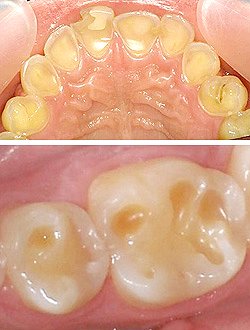
What is Tooth Enamel Erosion?
Dental erosion (tooth erosion) is the irreversible loss of tooth enamel due to chemical processes that do not involve bacterial action.
Tooth enamel is a mineralized hard tissue that covers and protects the tooth. It is the hardest tissue of human body but it can be chemically dissolved in an acidic environment. The acids that cause dental erosion may come from intrinsic (e.g., gastroesophageal reflux, vomiting) or extrinsic sources (e.g. acidic beverages, citrus fruits).
Tooth Erosion vs Tooth Decay or Abrasion
The tooth enamel loss caused by the acids produced by dental plaque bacteria (tooth decay) is not dental erosion. Other forms of tooth enamel loss caused by mechanical and not chemical factors are tooth abrasion and tooth attrition.
Tooth erosion is a slow progressive process that leads to the loss of the protective hard tissues of the tooth caused by exposure to acids for long periods of time.
Modern life-style and dietary habits are responsible for a sharp increase in the prevalence of dental erosion, especially in the young population of developed countries. Teeth erosion is becoming increasingly common and can have long-term consequences for the patient's dental health.
Dental erosion can cause mild tooth problems, such as tooth discoloration and mild sensitivity, to more severe dental problems, such as indentions in the teeth, severe tooth sensitivity, cracked teeth and tooth loss.
De & Re-mineralization of tooth enamel
If the tooth is exposed to acidic environment, the tooth enamel starts to loose minerals in a process called de-mineralization. Saliva slowly neutralises the acidity in the mouth and restores it to its natural balance. When the tooth’s environment becomes non-acidic the reverse process of re-mineralization begins. This natural tooth enamel restoration process repairs the enamel using minerals such as calcium from saliva and fluoride from toothpastes. If the two processes are balanced any damage to the tooth enamel is totally repaired.
Unfortunately there are many factors that disturb this delicate balance in favor of the de-mineralization resulting in irreversible tooth enamel loss. In the case of dental erosion, the problem occurs from the fact that the increased intensity and frequency of acid attacks does not allow enough time to repair and restore tooth enamel through re-mineralization.
Causes of Tooth Erosion
Tooth erosion generally occurs as a result of the chemical action of acids on the tooth surfaces. These acids that can be either extrinsic or intrinsic dissolve gradually the tooth enamel from the surface of the tooth.
Causes of tooth erosion due to extrinsic acids (from outside the body)
- Frequent consumption of acidic foods and drinks is the main cause of tooth enamel loss.
Even though fruit juices and fresh fruits are considered as healthy foods, their over-consumption is not the best option for teeth because they are too acidic (very low pH). Most of the popular carbonated drinks, soft drinks, sports drinks and diet drinks are also very acidic. Even fizzy mineral water can be acidic. Common extrinsic dietary acids include citric acid, phosphoric acid, ascorbic acid, malic acid and carbonic acid.
The erosive potential of acidic drinks does not depend on pH alone. Also, factors such as frequency and method of intake of acidic beverages as well as proximity of tooth brushing after intake may influence susceptibility to teeth erosion. Drinking through a straw lessens the contact time of the acids with the teeth. On the contrary, swishing the drink around the teeth increases their exposure to acids.
- Some medicines are acidic and, therefore, erosive. They can cause dental erosion on direct contact with the teeth when the medication is chewed or held in the mouth prior to swallowing.
- Environmental factors such as the chlorine and other chemicals in swimming pools can cause erosion over time.
Causes of tooth erosion due to intrinsic acids (from inside the body)
- Gastroesophageal reflux disease (GERD) or acid reflux, in which stomach acids come up into the oesophagus and mouth, can cause severe tooth erosion. Gastric acids are highly acidic with pH levels that can be less than 1.
- Eating disorders that cause frequent vomiting are also responsible for tooth enamel loss caused by the gastric acids.
- Bulimia (anorexia nervosa) is another frequent cause of eroded teeth due to chronic excessive vomiting. Besides vomiting, persons who suffer from bulimia tend to consume larger quantities of fresh fruits and acidic beverages that worsen the problem.
- Alcoholism could also cause vomiting related loss of tooth enamel.
- Low salivary flow rate is a significant risk factor for dental erosion due to reduced pH buffering capacity(its ability to neutralize changes in mouth’s pH)
Signs and Symptoms of Tooth Erosion
Teeth erosion affects the whole surface of the teeth, unlike tooth abrasion and attrition where the symptoms are isolated in specific areas of the tooth. Most of the symptoms of dental erosion are caused by the decreased depth of the tooth enamel layer that covers the crown of the tooth.
Early Symptoms of Tooth Erosion
- Teeth Discoloration - Since the dentin of the tooth is exposed during tooth erosion, discoloration or yellowing of the teeth can occur. The more dentin that is exposed, the more yellow the teeth will become.
- Tooth Sensitivity - Sensitive teeth are very common symptoms of teeth erosion because the enamel that protects the teeth wears away, leaving exposed the dentin (the softer, sensitive part of the tooth).
- Rounded/Shorter Teeth – Teeth with dental erosion have usually a rounded look. If the tooth enamel loss is extensive teeth might also look shorter.
- Transparency - The tips of the front teeth might look transparent.
Advanced Symptoms of Tooth Erosion
- Cracking - If tooth erosion continues, the edges of the teeth can start to crack and have a rough feeling.
- Pulp exposure in deciduous teeth
- Tooth decay – teeth affected by dental erosion are more likely to suffer from tooth decay.
![]() The cost involved with tooth restoration can be significant and many patients may not afford it if they are not covered by their dental insurance.
Learn how to choose a dental insurance plan that will provide the best dental treatment to yourself and your family.
The cost involved with tooth restoration can be significant and many patients may not afford it if they are not covered by their dental insurance.
Learn how to choose a dental insurance plan that will provide the best dental treatment to yourself and your family.


